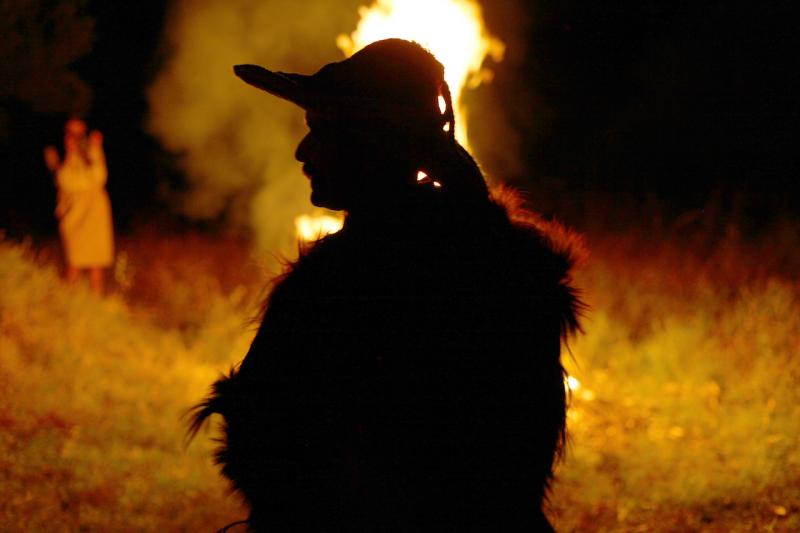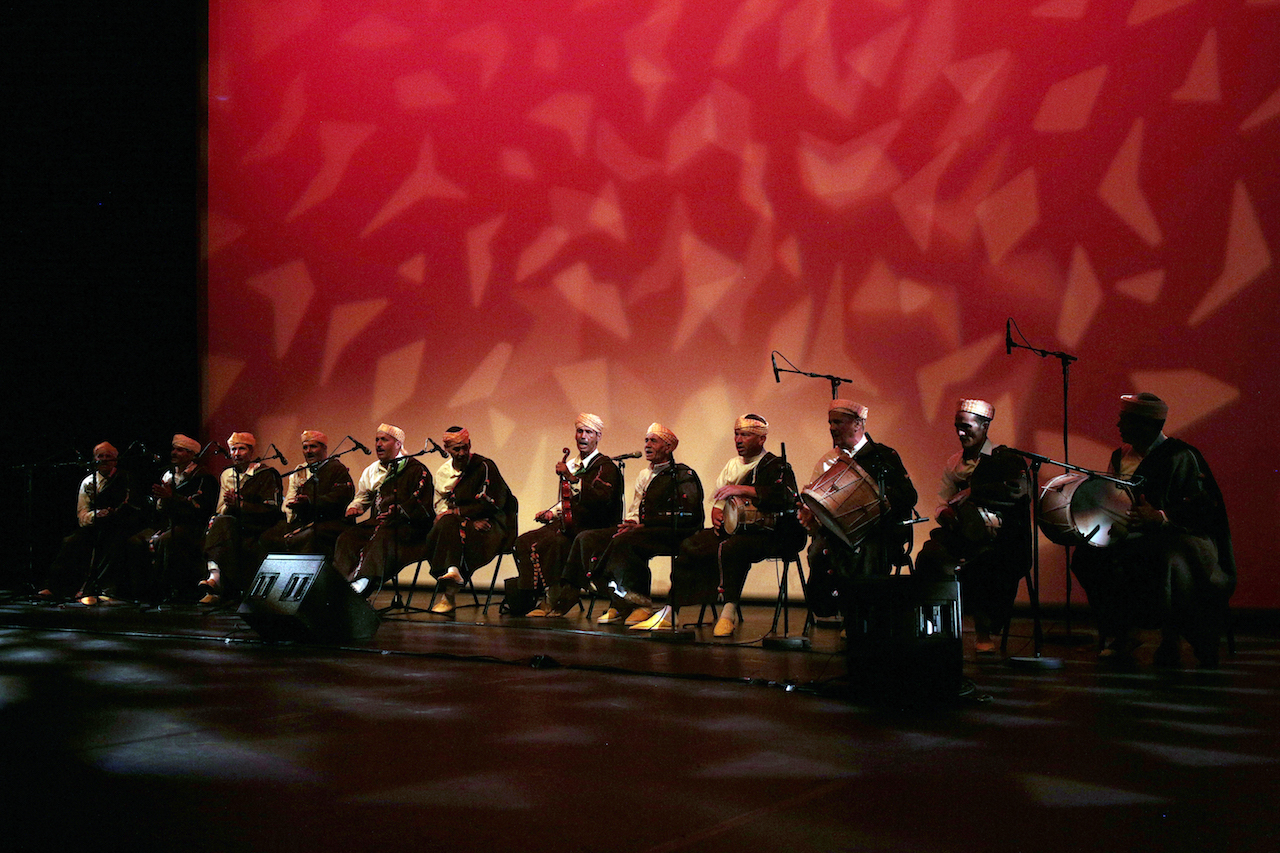The Master Musicians of Joujouka review - a 4000 year-old rock'n'roll band | reviews, news & interviews
The Master Musicians of Joujouka review - a 4000 year-old rock'n'roll band
The Master Musicians of Joujouka review - a 4000 year-old rock'n'roll band
Healing music from the Rif Mountains of Morocco

The Master Musicians of Joujouka, described by William Burroughs as a “4000 year-old rock’n’roll band”, and recorded by Brian Jones of the Rolling Stones in the late 1960s, have always been something of a cult – even in their own land.
I first heard them in 1980, when musical adventurer Rikki Stein, later manager of Fela Kuti, brought the musicians to Britain on their on their first tour, a low-key affair, that included informal outdoor venues at Dartington Hall and Port Eliot, and private parties at houses in London and Devon. It was at the time when Peter Gabriel and I were dreaming up WOMAD, and listening to a great deal of wonderful music from traditions we hardly knew. I wasn’t ready, though, for the mix of the visceral and spiritual that these gentle yet wild Moroccans were so keen to share with a new audience. Many, from Brion Gysin to Jarvis Cocker, Ornette Coleman to Robert Plant have spoken of the impact of this music – sounds that blast one’s head open in the way of a potent mind-altering substance, and light up the body, as if plugged into a cosmic form of the mains. The most startling feature of their sound are the raitas, high-pitched, harmonic-rich reed instruments that are kept going thanks to uninterrupted circular breathing. It wasn’t surprising to learn that the Master Musicians played at a shrine every Friday, for the benefit of people suffering from diseases of the soul.
This is music that trades on a great deal of hypnotic repetition, both in terms of the relentless rolling of polyrhythmic drums, and vocals that escape tempered unison and create instead an otherworldly and ceaselessly shifting pattern that eludes the mind’s quest for comfortable predictability. The same can be said of the interlacing of flutes that feature on some of the Joujouka musicians’s songs. Distortion, melisma, sliding up and down microtonal intervals: these departures from what someone trained in Western classical music would consider acceptable, have always been identified – in traditions that value them – as openings or fault-lines through which the ear can enable the listener to let go of normal consciousness, and connect with a source that offers healing and transcendence.
There is a moment on the newly released recording of a 2016 concert in Paris, on the track entitled “Brian Jones Zahjouka Very Stoned” when the solo vocal by Abdeslam Boukhzar hits some flat notes, surely unintentionally, even in a musical universe that makes a virtue of sliding tones. The backing vocals, essential to the call and response characteristic of so much North African music, are pitch perfect with carefully calibrated melisma that touches the heart but the solo feels slack. This is disappointing in the context of otherwise such scintillating music. The new double album features a very ‘live’ capture of a concert that sparkles with the atmosphere that is no doubt very different from the freewheeling, kif-fuelled ambiance of the Rif mountain village the musicians hail from. And yet, as with much trance music – the intrinsic power is not altogether absent when out of context. The recording is available on vinyl, and digitally, from 23 April. The treat is a 58 minute slice of the Boujedoud ritual that provides a climax to the Joujouka ritual. This long piece features the wild dance of a man wearing a goat skin. In the village he strikes onlookers, men and women with a branch, chasing away evil spirits, not least the female ‘demon’ Aisha Qandisha, who is also a feature of other trance ceremonies among the Gnaoua and the Aissaoua, other sects that work their healing all over Morocco. Boujeloud also confers blessings and fertility, albeit in a wild and unruly manner. The ritual is older than anyone can remember, and its origins are very likely connected with Dionysiac rites and the cult of Pan. Both gods were associated with animal fury and disorder, but a chaos out of which healing comes, restructuring the listener’s emotional and physical being. The frenetic drumming on the tabl, and the piercing sound of the raitas feel like chaos made music – and yet held together by a discipline that these master musical healers have passed on through the generations. This is, to use the words of musician Justin Adams, who is exceptionally familiar with the trance music of North and West Africa, a ‘soul science’, the knowledge around making music that enhances the spiritual and physical well-being of those who hear it.
The ritual is older than anyone can remember, and its origins are very likely connected with Dionysiac rites and the cult of Pan. Both gods were associated with animal fury and disorder, but a chaos out of which healing comes, restructuring the listener’s emotional and physical being. The frenetic drumming on the tabl, and the piercing sound of the raitas feel like chaos made music – and yet held together by a discipline that these master musical healers have passed on through the generations. This is, to use the words of musician Justin Adams, who is exceptionally familiar with the trance music of North and West Africa, a ‘soul science’, the knowledge around making music that enhances the spiritual and physical well-being of those who hear it.
The second time I heard the Master Musicians of Joujouka was on Plymouth Hoe, on a cold and damp day. I had arrived with flu, and a temperature of 39°C. I was feeling terrible. The raitas started up, along with the insistent clatter of the drums. I felt as if my heart, and indeed my whole body, were being assaulted: the high pitch, the endless stream of sound produced by circular breathing and the ear-splitting harmonics. I could feel as if my aches were melting away, and my body were being magically re-charged.
I became something of a groupie – the only time in my life – and followed the musicians for a few weeks, drawn so powerfully to the magic of their sound. They aren’t unique by any means, and the instruments they use to work wonders are found all over a trail that goes from the nadaswaram and thavil of South Indian temples to the zurna and davul of Roma bands that play at festivities in Turkey and throughout the Balkans. The sophistication of this simple yet effective ‘soul science’ is universal, and refined over many centuries. There are no side effects to this musical medicine – just a kind of bliss that makes the body and soul function at their highest potential.
- The Master Musicians Live in Paris to be released soon on Unlistenable Records
- More new music reviews on theartsdesk
Add comment
The future of Arts Journalism
You can stop theartsdesk.com closing!
We urgently need financing to survive. Our fundraising drive has thus far raised £49,000 but we need to reach £100,000 or we will be forced to close. Please contribute here: https://gofund.me/c3f6033d
And if you can forward this information to anyone who might assist, we’d be grateful.

Subscribe to theartsdesk.com
Thank you for continuing to read our work on theartsdesk.com. For unlimited access to every article in its entirety, including our archive of more than 15,000 pieces, we're asking for £5 per month or £40 per year. We feel it's a very good deal, and hope you do too.
To take a subscription now simply click here.
And if you're looking for that extra gift for a friend or family member, why not treat them to a theartsdesk.com gift subscription?
more New music
 Brìghde Chaimbeul, Round Chapel review - enchantment in East London
Inscrutable purveyor of experimental Celtic music summons creepiness and intensity
Brìghde Chaimbeul, Round Chapel review - enchantment in East London
Inscrutable purveyor of experimental Celtic music summons creepiness and intensity
 First Person: Musician ALA.NI on how thoughts of empire and reparation influenced a song
She usually sings about affairs of the heart - 'TIEF' is different, explains the star
First Person: Musician ALA.NI on how thoughts of empire and reparation influenced a song
She usually sings about affairs of the heart - 'TIEF' is different, explains the star
 Album: The Divine Comedy - Rainy Sunday Afternoon
Neil Hannon takes stock, and the result will certainly keep his existing crowd happy
Album: The Divine Comedy - Rainy Sunday Afternoon
Neil Hannon takes stock, and the result will certainly keep his existing crowd happy
 Music Reissues Weekly: Robyn - Robyn 20th-Anniversary Edition
Landmark Swedish pop album hits shops one more time
Music Reissues Weekly: Robyn - Robyn 20th-Anniversary Edition
Landmark Swedish pop album hits shops one more time
 Album: Twenty One Pilots - Breach
Ohio mainstream superstar duo wrap up their 10 year narrative
Album: Twenty One Pilots - Breach
Ohio mainstream superstar duo wrap up their 10 year narrative
 Album: Ed Sheeran - Play
A mound of ear displeasure to add to the global superstar's already gigantic stockpile
Album: Ed Sheeran - Play
A mound of ear displeasure to add to the global superstar's already gigantic stockpile
 Album: Motion City Soundtrack - The Same Old Wasted Wonderful World
A solid return for the emo veterans
Album: Motion City Soundtrack - The Same Old Wasted Wonderful World
A solid return for the emo veterans
 Album: Baxter Dury - Allbarone
The don diversifies into disco
Album: Baxter Dury - Allbarone
The don diversifies into disco
 Album: Yasmine Hamdan - I Remember I Forget بنسى وبتذكر
Paris-based Lebanese electronica stylist reacts to current-day world affairs
Album: Yasmine Hamdan - I Remember I Forget بنسى وبتذكر
Paris-based Lebanese electronica stylist reacts to current-day world affairs
 theartsdesk on Vinyl 92: Marianne Faithful, Crayola Lectern, UK Subs, Black Lips, Stax, Dennis Bovell and more
The biggest, best record reviews in the known universe
theartsdesk on Vinyl 92: Marianne Faithful, Crayola Lectern, UK Subs, Black Lips, Stax, Dennis Bovell and more
The biggest, best record reviews in the known universe
 Blondshell, Queen Margaret Union, Glasgow review - woozy rock with an air of nonchalance
The singer's set dripped with cool, if not always individuality
Blondshell, Queen Margaret Union, Glasgow review - woozy rock with an air of nonchalance
The singer's set dripped with cool, if not always individuality

Comments
I still have the original